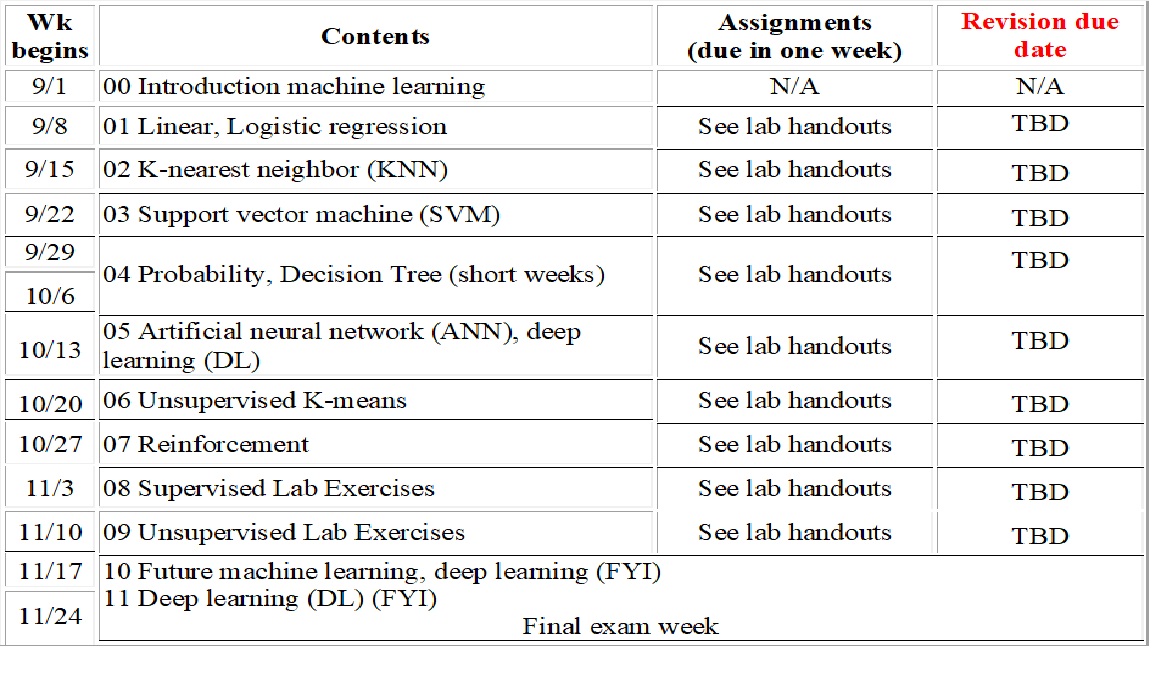Courses in Digital Technologies

Eat to survive, learn to become. Learning is not hearing, but giving voice.
▾ Home
▾ Courses
┃
┣ Prerequisite Knowledge
┃
┣ Fundamental Courses
┃
┣ Program-Specific Courses
┃
┗ Projects & Competitions
▸ Labs
Loading......
Password
Course Title and number: Syllabus of DT 3340 Machine Learning
Instructor: Dr. Dejang Liu, Professor
Prerequisite(s): Any college-level programming class or consent of the instructor
Start week of: Sep. 1, 2025
End week of: Nov. 24, 2025
Machine Learning 5 credit hours
Course Materials
Textbook (reference):
 Introduction to machine learning with Python, by Muller, Guido, O’Reilly, 1st edition, 2016, ISBN 978-1-449-36941-5, https://oreilly.com
Software (optional or per students’ preference):
Introduction to machine learning with Python, by Muller, Guido, O’Reilly, 1st edition, 2016, ISBN 978-1-449-36941-5, https://oreilly.com
Software (optional or per students’ preference):
• Python
• NumPy
• Google Co-Lab
• Jupyter Notebook
• SciPy
• Matplotlib
• Pandas
• Mglearn
• Orange
• KNIME
Learning outcomes/competences
• The students explain the history and basics of machine learning and establish the relationship to its practical applications.
• They master the use of common dimension reduction and feature selection methods in practical applications.
• They classify data using classification methods from statistical learning theory (such as support vector machines) and the field of artificial neural networks.
• They also use decision trees or discriminant analysis for this purpose.
• They use artificial neural networks to learn mappings between arbitrary input and output data (also for time series).
• They know different methods for parameter determination in artificial neural networks and use them in a targeted manner.
• They explain evolutionary algorithms and apply them.
• They have a comprehensive overview of machine learning methods and can assess which methods should be used in which application scenarios.
• They develop workflows for machine learning.
Learning contents
• Foundations of machine learning
• Data preprocessing
• Dimension reduction and feature selection
• Statistical learning theory and kernel methods
• Classification (support vector machines, decision trees, discriminant analysis, etc.)
• Artificial neural networks (self-organizing maps, multi-layer perceptions, recurrent topologies, extreme learning machines, reservoir computing, etc.)
• Method for parameter determination in artificial neural networks
• Evolutionary algorithms
• Workflows in machine learning
• Practical application examples from industry and the corporate world
Final Grade Assignment
Total Possible Points = 1000
A (90%) 900-1000 points
B (80%) 800-899 points
C (70%) 700-799 points
D (60%) 600-699 points
F 0-599 points
Lecture tenativeSchedule

Only on-time assignments are eligible for revision. Revise from the graded file rather than from a new one, so comments left in the graded file can be seen, or no credit for revision.
Deadline Date for Withdrawal:
Last day to withdraw from DT 3340: ??????, 2025
Deadline Date for Incomplete:
Last day to request an Incomplete in DT 3340: ??????, 2025
Chapter Assignments
To be announced in class.
Instructor’s Contact Information
Phone:
Office:
E-mail: